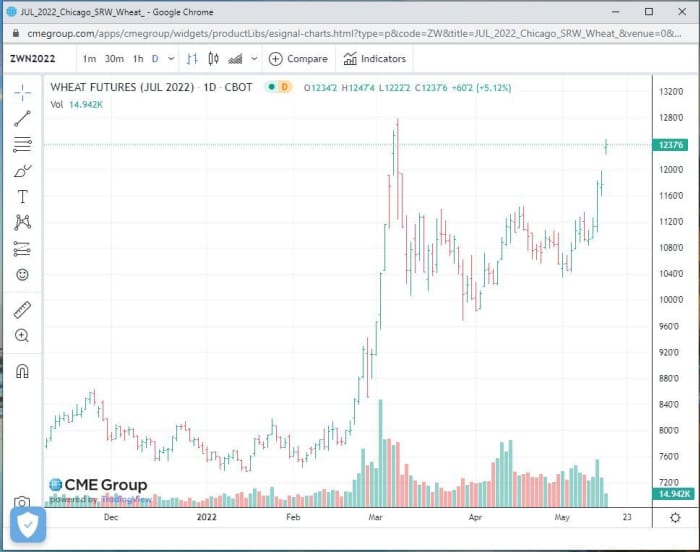Wheat futures climbed by the daily limit on Monday, following India’s plans to limit most of its exports of the commodity, as fallout from the Ukraine war continues to reverberate.
Soft red winter wheat for July delivery
W00,
rose 62 cents, the normal daily price limit, to lock at $12.39 a bushel, a gain of 5.27%. The contract hit a high as $12.47 a bushel, and its highest level since mid-March.
India on Friday announced an immediate ban on wheat exports, blaming a spike in global prices for threatening the security of the vital commodity to itself and other neighboring and vulnerable countries. The price of Chicago wheat futures has climbed 60% so far this year, in the wake of Russia’s late February invasion of Ukraine.
Russia and Ukraine together account for 25% of global wheat exports, with 13% of corn exports coming from Ukraine alone, according to RBC Capital Markets analysts. Russia’s invasion of its neighbour has triggered worldwide shortages of wheat and surging prices for bread and other staples.

CME Group
India’s Commerce Secretary B.V.R. Subrahmanyam told reporters on Sunday that the country’s wheat production has dropped by three million tons from 106 million tons last year. Prices have surged 20-40% in India.
However, India also said Sunday that it would continue to export to needy nations — the country mainly provides wheat to Bangladesh, Nepal and Sri Lanka. India consumes most of what it produces, exporting 7 million tons of wheat last year out of 109 million tons produced, said Subrahmanyam.
“India is not a big wheat exporter, but the fact that a big country scrambles to secure food supply left the market anxious with wheat prices up around 5% this morning,” analysts at Danske Bank, said in a note to clients on Monday.
Prices of other commodities, such as corn, have climbed 34% this year.
Ukraine’s Ministry of Agriculture said earlier this month that 30% of the country’s farmland was either occupied or unsafe, with mines planted and farmland destroyed. As well, Ukraine grains have been stuck in silos with Russian ships blocking main export routes along the Black Sea.
The U.S. Department of Agriculture last week issued its first world estimates for the 2022-23 crop season, forecasting a decline in wheat production for both this year and next.
